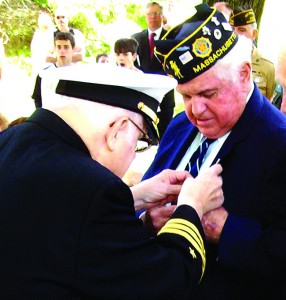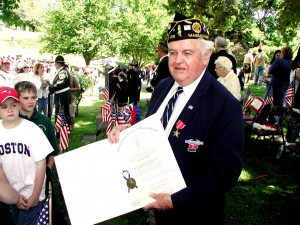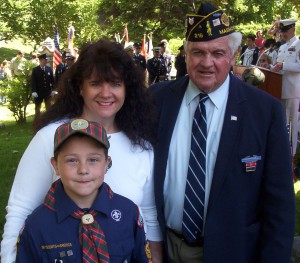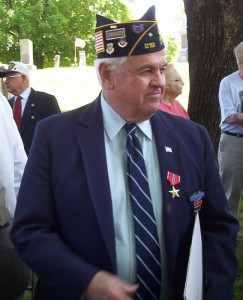By: Ted Trip – June, 2011
 NORTH ANDOVER – On the morning of June 6, 1944, the allies finally began the liberation of Europe from the Nazi nightmare.
NORTH ANDOVER – On the morning of June 6, 1944, the allies finally began the liberation of Europe from the Nazi nightmare.
Tens of thousands of American, British and Canadian troops poured onto the shores of Normandy to engage the Germans and drive them out of France. The allies had trouble at first fighting through the treacherous area, but by late fall, General Eisenhower’s armies were nearing the German border.
As the Americans advanced, Private 1st Class, Jim Cassidy of the Machine Gun Squad were attempting to enter Rylan Town, when almost immediately, they were pinned down by a German sniper perched high on the church steeple. There was little they could do as they hunkered down into their foxholes to avoid the bullets whizzing by. Finally, late in the day, they moved out and demolished the church. Once again, the squad, in the hands of so many times before, picked up their gear and pushed forward with the rest of their unit during that bitter, cold winter of 1944-1945. 18 year old Jim Cassidy was just one of the many young men who would step forward to risk their lives in the world wide struggle for freedom against the acts. He and his men were typical of what Tom Brokaw call the Greatest Generation.
 Jim was born in 1926, he grew up in Worcester. He vividly recalled the day WWII began. On the evening of December 7, 1941, Jim and his brother, Bill, were on their way home from the movies. They noticed on the trolley car that there was talk about the Japanese bombing Pearl Harbor and some women were crying. The brothers did not know what or where Pearl Harbor was, but they knew the news was bad.
Jim was born in 1926, he grew up in Worcester. He vividly recalled the day WWII began. On the evening of December 7, 1941, Jim and his brother, Bill, were on their way home from the movies. They noticed on the trolley car that there was talk about the Japanese bombing Pearl Harbor and some women were crying. The brothers did not know what or where Pearl Harbor was, but they knew the news was bad.
The next day, the Cassidy family learned from their parlor radio, that the country was at war. When Jim turned 17, he tried to enlist in the Navy, but was turned away because of a minor vision problem. So, he returned to high school for his senior year. He graduated early, February 1944 and shortly after his 18th birthday, was drafted into the Army. He recalled that when his mother went to pick up his diploma, later that spring, she remarked at how many empty seats there were for those who also had already gone into the service.
May 15, 1944, Jim reported to Fort Devens for induction. The Army then shipped him off to Fort McLellon, Alabama for 17 weeks of infantry training in the tropical heat of summer. Jim was sent to Fort Leonard Wood, Missouri for additional training and after a short leave at home, was ordered to camp Miles Standish in Taunton. He arrived in a blinding snow storm. This was his final stop before shipping out to Europe. At this point, Jim was assigned to the 70th infantry division, famously known as “The Trailblazers”. Through all of this, Jim was paid $30.00 per month.
 November 1944, Jim Cassidy boarded the Troop Ship out of Boston and headed to France. The trip over there was uneventful, but Jim remembers his arrival on December 10th very well. There was mud everywhere and it was cold. He pitched his tent in the ever present mud and awaited orders to the front. 10 days later, he and the other troops were loaded and started to head towards France. 500 miles later, they arrived at their destination. It was Christmas Eve, the next day, Christmas, Jim remembered it well. He went to open his rations for dinner and they were full of ice. Jim had been assigned to Company H274th regiment of the 70th division 7th Army. Company H carried heavy weapons to support the infantry primarily machine guns and mortars. Jim was part of the Machine Gun Squad, an 8 man unit operating the 30 caliber machine gun. The unit consisted of the number 1 gunner who can carry the heavy support and tripod. The number 2 gunner carried the machine gun itself and 6 ammo carriers who each hauled two boxes of the 250 round cartridge belts. Jim began as an ammo carrier, but quickly moved up to gunner as other squad members became casualties. Promotion during the war was likely to be based on survival as well as battlefield skills. The 274th fought during Hitler’s gas attack in the battle of the bulge. The gymnast division moved forward from France into Germany, they endured constant shelling and sniping fire. They lived in fox holes during one of the coldest winters Europe had seen in many decades. Jim carried extra socks and inner souls in his parker to keep his feet dry. Dry feet and warm feet and no frost bite.
November 1944, Jim Cassidy boarded the Troop Ship out of Boston and headed to France. The trip over there was uneventful, but Jim remembers his arrival on December 10th very well. There was mud everywhere and it was cold. He pitched his tent in the ever present mud and awaited orders to the front. 10 days later, he and the other troops were loaded and started to head towards France. 500 miles later, they arrived at their destination. It was Christmas Eve, the next day, Christmas, Jim remembered it well. He went to open his rations for dinner and they were full of ice. Jim had been assigned to Company H274th regiment of the 70th division 7th Army. Company H carried heavy weapons to support the infantry primarily machine guns and mortars. Jim was part of the Machine Gun Squad, an 8 man unit operating the 30 caliber machine gun. The unit consisted of the number 1 gunner who can carry the heavy support and tripod. The number 2 gunner carried the machine gun itself and 6 ammo carriers who each hauled two boxes of the 250 round cartridge belts. Jim began as an ammo carrier, but quickly moved up to gunner as other squad members became casualties. Promotion during the war was likely to be based on survival as well as battlefield skills. The 274th fought during Hitler’s gas attack in the battle of the bulge. The gymnast division moved forward from France into Germany, they endured constant shelling and sniping fire. They lived in fox holes during one of the coldest winters Europe had seen in many decades. Jim carried extra socks and inner souls in his parker to keep his feet dry. Dry feet and warm feet and no frost bite.
Perhaps Jim’s closest brush with death came when a screaming Mimi, which was the GI hitman for German 88 artillery sheller rocket. One landed no more than 10 feet from Jim’s position. Fortunately it was a dud. It did nothing more than spread lots of dirt and debris. But, Jim said it sure did scare the hell out of him.
 As the 274th fought its way into Germany, his unit was called back every so often and allowed a 1 minute hot shower, given clean underwear and served some hot meals. One time, Jim was even given a 3 day pass to Paris. It was his first time seeing electricity since leaving in December. Despite the primitive conditions, the troops were kept to date on the news by the armed forces radio and the Stars and Stripes. Jim remembered vividly that sad day in mid April when their commander and chief, President Roosevelt, died.
As the 274th fought its way into Germany, his unit was called back every so often and allowed a 1 minute hot shower, given clean underwear and served some hot meals. One time, Jim was even given a 3 day pass to Paris. It was his first time seeing electricity since leaving in December. Despite the primitive conditions, the troops were kept to date on the news by the armed forces radio and the Stars and Stripes. Jim remembered vividly that sad day in mid April when their commander and chief, President Roosevelt, died.
As the war wound down in the spring of 1945 and Germany’s surrender was near, Jim remembered the 274th taking many prisoners. A substantial number were no more than 12 or 13 years old as the German army exhausted its supply of regular troops. After the Germans had surrendered to the allies in early May, Jim and the 274th immediately began plans to go to the Pacific for one more battle. This was for the invasion of Japan and they distinctly knew the casualties would be very high. His unit was still training in Europe when the Atomic bombs were dropped on Hiroshima and Jim remembered the jubilation and relief for the troops when Japan surrendered. Instead of one more battle to fight, they would be going home.
In early January, 1946, Jim boarded the Liberty Ship SS John Holland for New York. He had been in Europe for 13 months, he was eager to get back into the states. He told me that he will always remember the sight of that beautiful lady, the Statue of Liberty, as his ship made its way into New York Harbor.
On May 1, 1946, Jim was discharged from the Army. After the war, Jim used the GI Bill to attend UMass and Fort Devens campus. He studied Agriculture and went on to a distinguished career with the Massachusetts Department of Agriculture. For 37 years, he was the State’s director of enforcing regulations on fruits and vegetables.
On July 4, 1947, Jim met his future wife, Lorraine, at Hampton Beach. They were married in 1950 and in 1954, moved to North Andover where they lived until 2005. Jim was well known around town for promoting the American spirit. Along the way, he helped countless Veterans and seniors and anyone else who needed a helping hand. Jim, this Memorial Day, we thank you for who you were, we thank you for your service to our country.
Transcribed by Dawn Brantmuller
